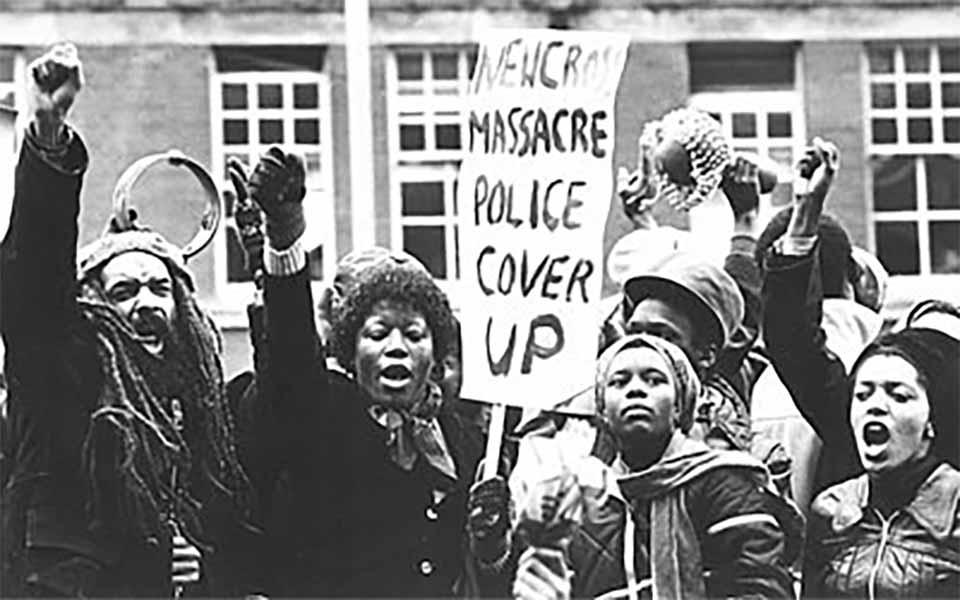New Crass Massahkah: Remembering the fire at 439 New Cross Road
Primary page content
In the early hours of Sunday 18 January, 1981, a devastating fire engulfed party-goers at a birthday celebration being held at 439 New Cross Road for Yvonne Ruddock and Angela Jackson.

In the final death toll 14 young black people between the ages of 14 to 22 had their futures stolen from them that night. Thirteen died in the fire from burns and suffocation while one victim committed suicide two years later unable to live with the memory of its aftermath.
As a teenager I remember passing the ruined house at 439 New Cross regularly on my way to college at Goldsmiths. In the doorway was a makeshift memorial stating “thirteen of our children murdered” and beneath these words was a list of their names. The burnt out three-storey house was a reminder of the nature of the offence like an open wound scorched in the body of the city.
Eye-witness accounts pointed to arson and the suspicious behaviour that night of a man who drove off in a white Austin van. Fire had been a staple weapon of racist violence and there had been other arson attacks on black community centres and youth clubs. Some 35 years later the origins of the fire are still unknown.
It is important to remember the shameful indifference to these deaths at the time within the media and the political establishment.
In the days that followed there was little coverage of the terrible loss of young life in the newspapers, with the exception of The Sun reporting it on their front cover, and no statement of condolence from then Prime Minister Margaret Thatcher.
The cold silence of the white establishment conveyed a brutally simple message that the loss of young black lives was simply unimportant. As Johnny Osbourne sang pointedly ’13 Dead (and Nothing Said)’.
Out of the ashes of this terrible tragedy came an unprecedented political mobilisation led by the families, the New Cross Massacre Action Committee and the wider black community.
It resulted in the historic ‘Black People’s Day of Action’ on Monday 2 March, 1981, where 15,000 people from all over the country filed by 439 New Cross Road bound for the Houses of Parliament and Fleet Street. As Paul Gilroy commented recently, photographs of the young people who lost their lives were carried as a demonstration that their humanity mattered.
In a way this is my lasting memory. It was that sense of shock that this is where racism leads - to a massacre, not of what the media grudgingly referred to as ‘West Indian youngsters’, but to the murder of your neighbours, classmates and friends.
A few years later I interviewed a white young woman called Debbie. She said: “I remember the New Cross Fire because I was quite friendly with the people who lost kids in that fire and I knew quite a few kids… I felt that quite personally, I was really upset by that. I went on the march and things. I remember it rained. I got soaked to the skin… That actually did a lot to bring the community around here together… both black and white people.”
Saying nothing in the face of racism was - and is - complicity, whether it is the media at the time ignoring that the violence happened at all or police harassment and neglect or laughing at the jokes of racist comedians or agreeing with casual hatred conveyed over the kitchen table. Being proximate to these events for white residents - like myself - was also a lessons in political humility and learning what it meant to be against racism but respectful of the true costs borne by its victims.
In her history of black Lewisham Professor Joan Anim-Addo describes the meeting that was held in Deptford Town Hall on the first anniversary of the fire. At that meeting John La Rose described the fire as “an unparalleled act of barbaric violence against the black community in this country".
It wouldn’t be the last time that black young people would encounter murderous racism on the streets of south London.
Linton Kwesi Johnson’s ‘New Crass Massahkah’ conveyed in dub poetry perhaps the most enduring and powerful form of historical witness. Thinking back now perhaps the most appropriate way to remember those lives cut short so cruelly is to renew a commitment and vigilance to challenging contemporary racism in all its forms.